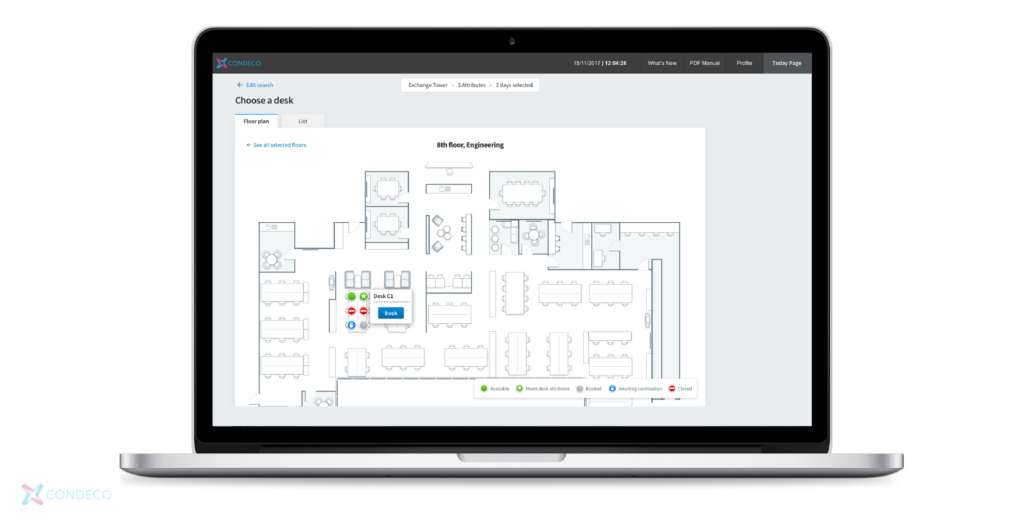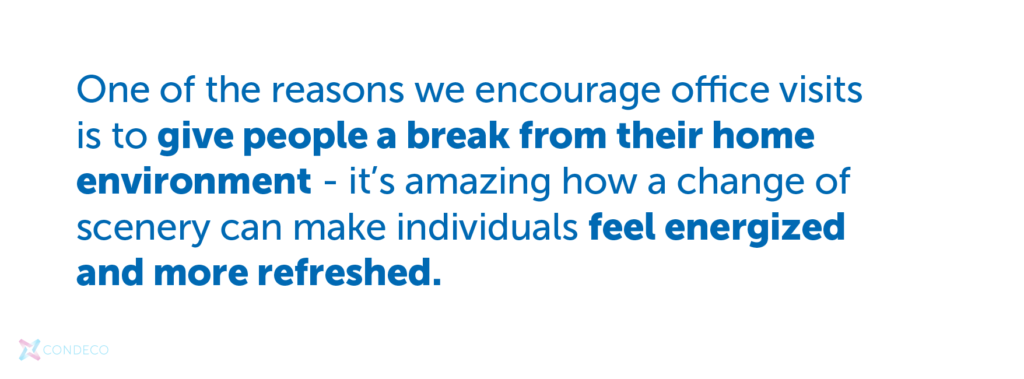
As a company that promotes flexible work software solutions, we’re often asked about our own approach to hybrid work. We’re proud of the part we play in helping organizations across the world embrace hybrid work and are pleased to say that we do practice what we preach.
We talked to Kajal Patel, Head of HR at Condeco in London, about the journey we’ve taken over the past few years and how we organize our workforce to make the most of the benefits offered by flexibility.
How did Condeco move to hybrid?
KP: Like many organizations pre-covid, most of our employees would spend the working week in the office unless their duties required them to travel offsite. Then the pandemic happened, forcing the world into lockdown, and the company had to adapt to a different way of working. It soon became apparent that this change was an opportunity as much as a challenge and one that we embraced.

We saw how people had the ability to work just as productively from home, if not more so. Due to fewer distractions, individuals could just get on with the task at hand. This opened the opportunity to look at introducing a more permanent hybrid work model and implementing this across the organization simply made sense.
What are Condeco’s working arrangements?
KP: We try not to set any fixed rules but give our employees and managers the choice on how to manage their days to get the best out of them. So, in terms of office visits, we don’t specify when and how many times they should come in each week. If managers want to request that their team get together for collaboration purposes or important meetings, they will request for their team to attend the office.
That means each of those meetings has a real purpose and is arranged when it’s most convenient for the people involved. If team members can’t come into the office on a particular day, we have video conferencing facilities available, such as Microsoft Teams and Zoom to make things simple.

How has your office changed since hybrid working began?
KP: The office hasn’t changed much. We had to adapt the workspace to meet social distancing measures that were in place for the past couple of years, but now we’re set up to cope with fluctuations in daily demand. We’ve also made certain workspaces in the office only available to specific departments and teams for confidentiality purposes, for example, HR, Finance, and IT who have their own designated areas. The people within those teams can book any of the desks within that area. However, the rest of the office is available to all employees, who secure their personal spaces through our workspace booking software, ensuring everyone has the certainty they will have the space they need when they come into the office.

Is the main office much quieter now?
KP: As you’d expect, certain employees want to come into the office more than others, but the option is there for everyone. There are definitely days when we have fewer people in the office than before the pandemic. Wednesdays and Thursdays seem to be the most popular days for collaboration and team meetings, and on other days there will be fewer people using the space.
The company has the ability to cope with either requirement. You can definitely see that coming into the office has a new sense of occasion for those who have been at home. Generally, people have embraced the new hybrid way of working and enjoy having the choice and flexibility it gives them.
What are the health and well-being challenges?

KP: When people work from home it is harder to keep track of their mental health. One of the reasons we encourage office visits is to give people a break from their home environment – it’s amazing how a change of scenery can make individuals feel energized and more refreshed. We also have a health and well-being channel as part of our learning and development platform, which provides a wealth of information and tips on wellness, mindfulness, and achieving a healthy work/life balance. For example, in our India office, we run a host of wellness activities such as virtual yoga sessions and wellness sessions on how to take care of yourself.
In terms of ensuring people are managing their time sensibly, we encourage employees to be flexible in their working day. For example, ensuring individuals are taking regular breaks throughout the day and switching off from work at the end of the day.
As a multinational company, how does hybrid work?
KP: As a global company, we have to keep in mind the variations in laws and work cultures for each country we have offices in, which means we cannot go by the principle of one size fits all. In the beginning there were some challenges around understanding how hybrid working would work across Condeco, but over the course of the year, all employees across the company have adapted well to this new way of working.
Is hybrid working the future?

KP: Hybrid working is quickly establishing itself as the new way of doing things across many parts of the world, and I do believe hybrid working will become the new norm for the majority of organizations moving forward, opening up a range of opportunities for employees and employers. The challenge of hybrid working, however, is how employers manage it and make it their own, while maintaining high levels of productivity.



